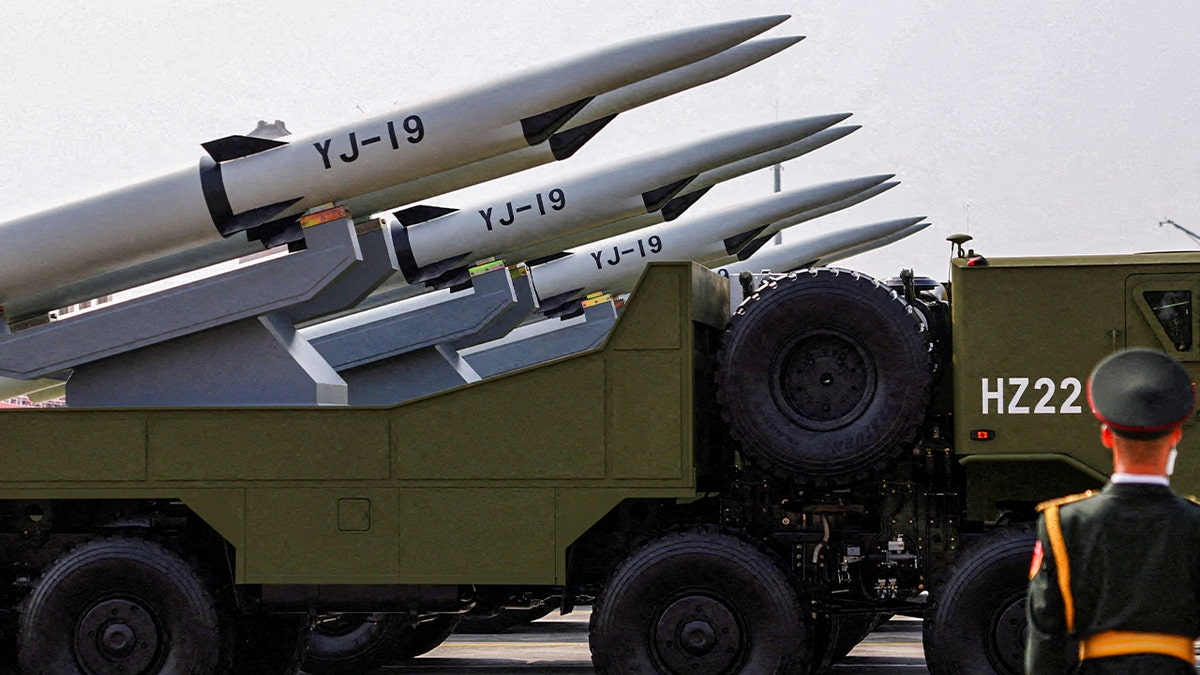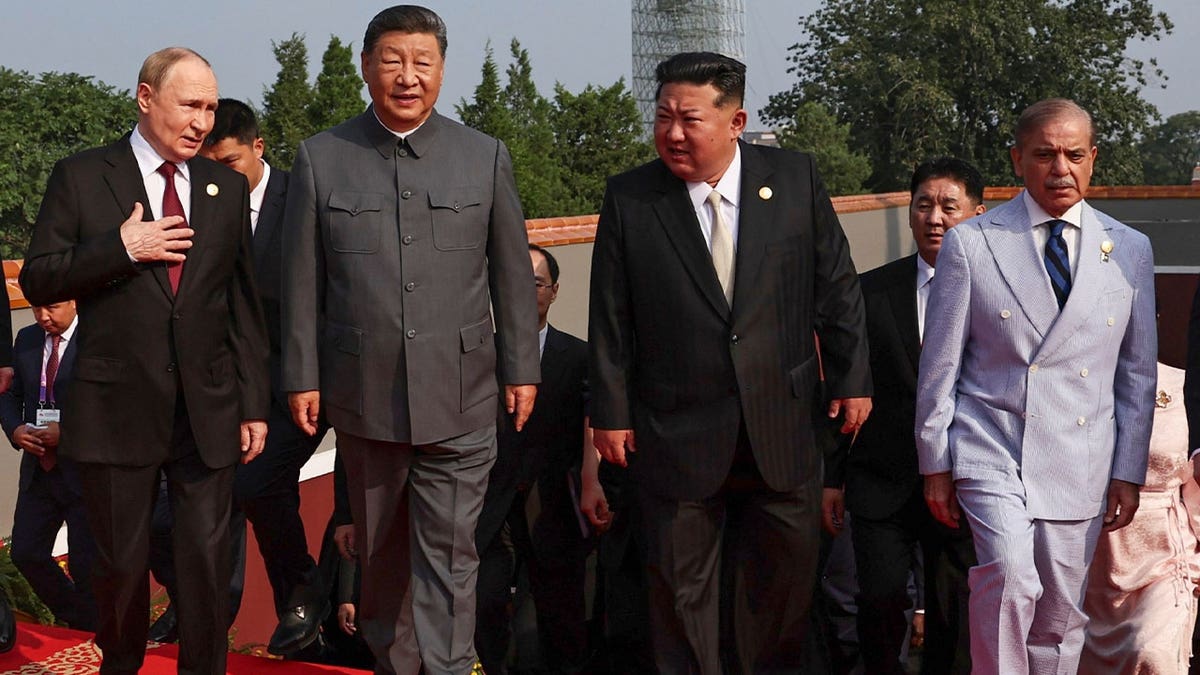

China recently rejected President Donald Trump’s offer to discuss nuclear arms reductions. Then, shortly after, Beijing revealed new weapons in its World War II parade, a celebratory affair that Russia’s Vladimir Putin and North Korea’s Kim Jong Un also enjoyed.
The parade included a variety of cutting-edge technologies, but the nuclear delivery systems stood out. The Chinese military showcased a full triad of improved capabilities: silo-launched intercontinental ballistic missiles, an air-launched ballistic missile and a submarine-launched ballistic missile.
Just three years ago, China denied it was rapidly building up its nuclear arsenal. In 2022, Fu Cong, then the director-general of the Chinese Foreign Ministry’s arms control department (now China's permanent representative to the United Nations), told reporters that China was maintaining only a minimum deterrent necessary to defend itself.

The People's Liberation Army's maritime operations group displays YJ-19 hypersonic anti-ship missiles during a military parade to mark the 80th anniversary of the end of World War II, in Beijing, China, Sept. 3, 2025. (Tingshu Wang/Reuters)
Minimum deterrence is a strategy based on the assumption that a nation needs only to possess enough nuclear weapons to survive a first strike and credibly threaten a retaliatory strike sufficiently destructive in the mind of its adversary that the original act of aggression is deterred. Although the exact numbers that would meet those criteria are difficult to discern, the size of the force is modest.
CHINA SHOWS MISSILES, TRUMP SHOWS MUSCLE: XI'S STRATEGY CAN'T MATCH US
China also continues to insist that it holds a no-first-use policy. This means it would not use a nuclear weapon against a nation first, but only in response to an attack. In theory, this policy would complement its alleged minimum deterrent strategy, but its nuclear investments belie both claims.
Four years ago, then Stratcom Commander Adm. Charles Richard publicly warned that it is more useful to watch what the Chinese are doing than what they were claiming. China was amid what he called a "strategic breakout." The military exercises between China and Russia were becoming more frequent, too, making what he described as "breathtaking" expansion even more alarming.
The Chinese were quickly expanding the size of their nuclear force and investing in diverse systems, and they were on a trajectory that suggested a challenge to the U.S. deterrent force, which is only designed to deter one major nuclear power, not two simultaneously.
Because of this, Adm. Richard concluded that, while it was impossible to know exactly how Xi Jinping might think about the purpose of the nuclear force, "what matters is they are building the capability to execute any plausible nuclear employment strategy – the last brick in the wall of a military capable of coercion."
TRUMP'S TARIFFS FORCE CHINA TO FEEL THE HEAT
Any successful act of coercion relies on a nation’s adversary believing that it has the capability and willingness to attack. And Beijing is working on a force to convince Washington of that. Not only is China building a large and diverse nuclear arsenal that can reach U.S. ships, bases and allies, it is mixing its nuclear and conventional weapons on dual-capable systems. And China’s strategic nuclear breakout is leading up to the time when U.S. officials have assessed China may try to take Taiwan by force (2027).
A 2024 annual Department of Defense report to Congress described China’s nuclear force as including "low-yield precision strike missiles to ICBMs with multi-megaton yields to provide it options at every rung of the escalation ladder."
That same report also said, "DoD estimates that the PRC will have over 1,000 operational nuclear warheads by 2030, much of which will be deployed at higher readiness levels, and will continue growing its force to 2035 in line with its goal of ensuring [People’s Liberation Army] modernization is ‘basically complete’ that year, an important milestone on the road to Xi’s goal of a ‘world class’ military by 2049."

Russian President Vladimir Putin, Chinese President Xi Jinping, North Korean leader Kim Jong Un and Pakistani Prime Minister Shehbaz Sharif arrive at a military parade to commemorate the 80th anniversary of Japan's World War II surrender in Beijing, China, Sept. 3, 2025. (Alexander Kazakov, Sputnik, Kremlin Pool Photo via AP)
The report also noted that China will probably use its new fast breeder reactors and reprocessing facilities to produce plutonium for its nuclear weapons. Just like when China said it was keeping a minimum deterrent and a no-first-use policy, it was lying about this. Chinese officials claimed that these technologies are for peaceful purposes.
FIDDLING WHILE ROME BURNS: AMERICA IGNORES CHINA’S RISING RED TIDE
After China’s recent parade, I asked retired Adm. Richard what he made of it. He told me, "I think it's important to look at it in totality. They are advancing rapidly in all aspects necessary for a military designed for aggression." The new information, all publicly available, shows that the admiral was right when he sounded the alarm several years ago.
And while the nuclear expert community has found a consensus on the need to quickly modernize and adapt the U.S. nuclear force to deter Chinese aggression, decision-makers in the Pentagon have not fully grappled with this change. For example, the Biden administration did not make sufficient changes to field a nuclear deterrent force that could deter China and Russia simultaneously.
To preserve the peace, the Trump administration should do the following:
One, fully modernize the program of record by replacing its nuclear delivery systems; modernizing its warheads as well as U.S. nuclear command, control, and communications; and recapitalizing the nuclear enterprise infrastructure.
TRUMP LEARNS A LESSON GROUNDED IN FAITH, HOW BEST TO STAND TOUGH ON TRADE WITH CHINA
The total cost of this is disputed, but the upper range of the estimates is roughly 7% of the national defense budget, whose entire budget is less than 4% of the nation’s gross domestic product. To prevent nuclear war and preserve the peace, this is more than a bargain.
Two, formally terminate the New Strategic Arms Reduction Treaty (START) with Russia, which expires in February 2026. Russia announced during its invasion of Ukraine that it would no longer abide by the treaty’s accounting requirements.
If the United States decides to stay within the confines of New START—when there is no way to determine if Russia is doing the same, and when China is completely unrestrained by a treaty – then Washington would be unilaterally restrained when it desperately needs to adapt its force to deter the growing Chinese arsenal.
President Trump understood the foolishness of remaining bound by the Intermediate Nuclear Forces (INF) Treaty during his first term when Russia was cheating on it and formally withdrew from it. The same logic applies to New START today.
Three, bolster theater nuclear deterrence in the Pacific by speeding up the delivery of the Sea-Launched Cruise Missile (SLCM-N), a program President Trump initiated during his first term. The first Trump administration explained that it was adding this "prudent" option to enhance "the flexibility and diversity of U.S. nuclear capabilities… by signaling to potential adversaries that their limited nuclear escalation offers no exploitable advantage."
The Biden administration did not support President Trump’s initiative until the end of its term, losing significant time. Now President Trump has the ability to speed up efforts to deliver this critical capability in time to deter Chinese aggression.
Additionally, the next generation bomber, the B-21, will be instrumental for deterring China and assuring allies. And as its older cousin, the B-2, showed off against the illicit Iranian nuclear program in Operation Midnight Hammer, stealth bombers are a threat to the most deeply buried targets inside enemy territory.
The Air Force plans to produce 100 B-21s, but adding a second production line and doubling the production output would be wise. This would also bring down the cost per item while delivering a powerful deterrent that the president can use across geographic theaters.
China claims that it has a minimum deterrent, follows a no-first-use policy and uses nuclear technology for peaceful purposes. None of that is true. For the sake of peace, the United States should boost the credibility of its nuclear deterrence accordingly – and fast.
